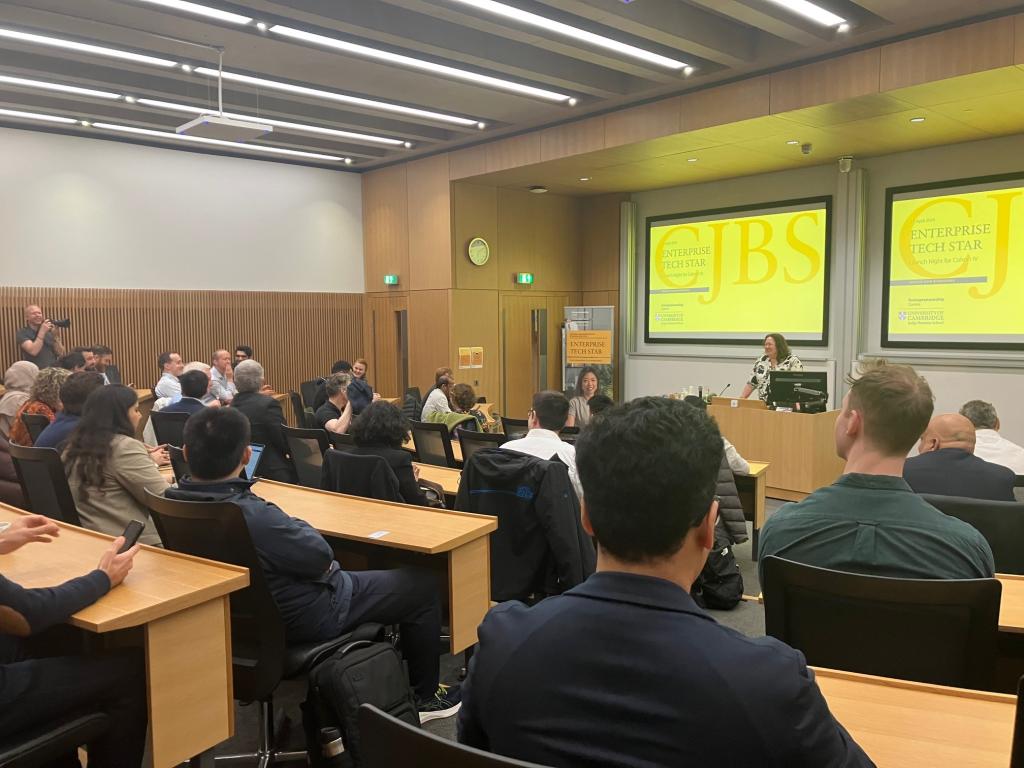I delighted in one of the highlights of my year last week:
The launch of Enterprise TechStar, an excellent programme to teach aspiring entrepreneurs at the Cambridge University Judge Business School.
.
I’m proud to be giving lectures in advanced business messaging, and leadership communication, as well as mentoring the students.
But the point of this blog is how to introduce yourself when you need to impress, and you only have a few seconds.
- Step forward the legendary elevator pitch.
.
If you don’t know the concept, the idea is that you’re in a lift…
When in steps your ideal customer, employer, or investor.
You only have the time taken for the lift to move between floors to engage them, interest them, and secure a follow-up meeting.
Which is quite a challenge!

On Enterprise TechStar launch night, above, those of us teaching and mentoring had to introduce ourselves with an elevator pitch.
Which made me think it would be worth outlining the gold standard for how it’s done.
.
The Essentials of an Elevator Pitch
The first thing to remember is you only have around 30 seconds for an elevator pitch, which equates to about 100 words.
That means you’ve probably got time to make three or four points.
So it's critical to make sure they resonate with the audience - whether one person, or dozens.
.
To help, put yourself in their position.
What will most impress them?
For me, as I was teaching communication skills, I said:
- I lead a course in public speaking, writing and storytelling here at the University of Cambridge.
- I run my own business communications consultancy, Creative Warehouse.
- For 20 years, I was BBC radio and TV News Correspondent, largely specialising in business and economics.
.
Elevator Pitch Extras
As it turned out, I had a little extra time.
That happens, so it's worth having more material to air if you get the opportunity.
At Enterprise TechStar, I added my writing experience:
- 12 books on business and communication, a new book to be published next month, titled Compelling Communication, to accompany my Cambridge University course…
- Some short stories, BBC radio comedy, a play, and even a pantomime.
.
That last element I wanted to add as it was a good way to end the pitch with a smile.
Which is always handy: the injection of some character can bring warmth and help make a connection.
.
Elevator Pitch Adaptations
It's worth remembering to adapt your elevator pitch for different situations.
For example, if I was teaching Media Careers to students at Cambridge, as I sometimes do with the undergraduates.
Then, I would begin with my BBC experience, before going on to my Compelling Communication Skills course, and writing work.
Why? Well, because that would be the most appropriate for the situation, and most likely to engage and impress the students.
.
The lesson being a familiar one:
Always put your best material right up front.
You don't get a second chance to make a strong first impression.
.
Likewise, if I was teaching writing, I would begin by talking about my publications.
Because, once more, that was the most audience appropriate.
.
The Elevator Pitch in Practice
In the real world, you would soften the start of your elevator pitch depending on who you were talking to.
That means beginning with a few words like:
– As someone interested in this line of business…
- Given the company you run…
- In light of your research, I think you’ll find my work worth exploring…
.
You might also try a broad, bold and big picture opening.
For example, for my Enterprise TechStar elevator pitch, I began by saying:
- My job on this excellent programme is to solve all your communication problems.
That worked well in getting attention, appealing to that specific audience, and then leading elegantly into talking about my experience, as above.
.
Elevator Pitch Endings
It's a sadly common mistake, so please don't fall into this trap.
You've delivered a cracking elevator pitch, the person or audience has been impressed...
But you forget to secure a follow up of some kind.
.
For Enterprise TechStar, as my lectures and mentoring were already scheduled, it was simple:
- I look forward to working with you in the coming weeks.
.
But if you're addressing a group, or a conference, don't forget to put your email address, or social media profiles up on screen.
If it's a one on one, classic elevator pitch scenario, swap business cards, WhatsApp numbers, or email addresses.
Anything, so long as your good work in making such a fine impression isn't then wasted.
.
Elevator Pitch Introductions
There's one final point to mention, given that you've probably spotted such an obvious omission.
You should, of course, introduce yourself. It’s only polite.
But! You don’t have to do so in the first line, in the entirely conventional, and not terribly exciting manner.
You can introduce yourself in the second, or even third or fourth line.
That way, you start with by far the most interesting and important information...
Which is a much more effective strategy for ensuring impact and engagement.



